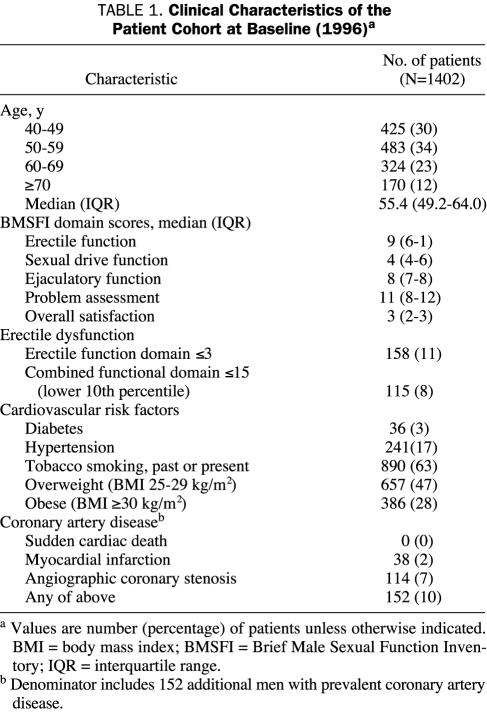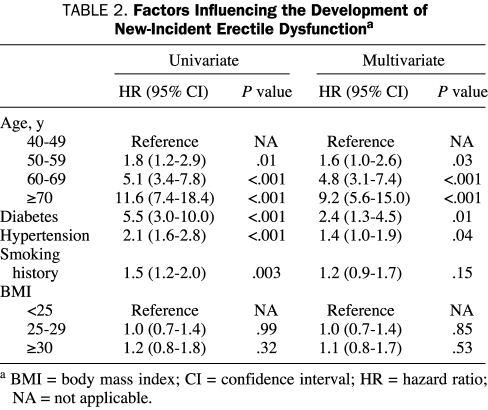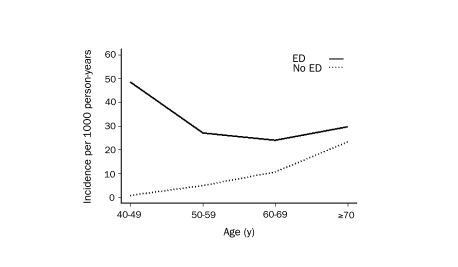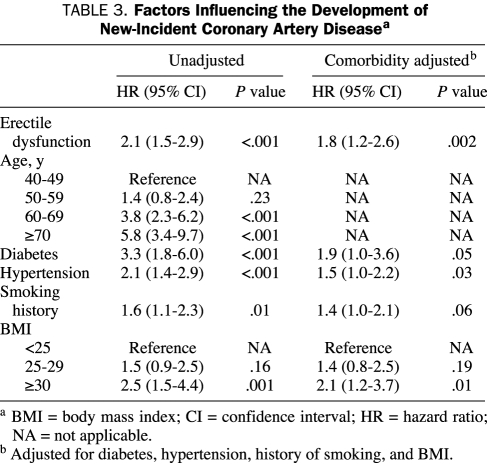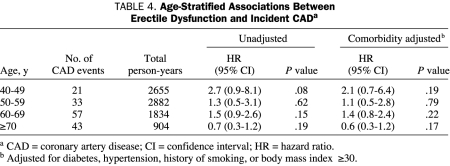Abstract
OBJECTIVE: To assess the association between erectile dysfunction (ED) and the long-term risk of coronary artery disease (CAD) and the role of age as a modifier of this association.
PARTICIPANTS AND METHODS: From January 1, 1996, to December 31, 2005, we biennially screened a random sample of 1402 community-dwelling men with regular sexual partners and without known CAD for the presence of ED. Incidence densities of CAD were calculated after age stratification and adjusted for potential confounders by time-dependent Cox proportional hazards models.
RESULTS: The prevalence of ED was 2% for men aged 40 to 49 years, 6% for men aged 50 to 59 years, 17% for men aged 60 to 69 years, and 39% for men aged 70 years or older. The CAD incidence densities per 1000 person-years for men without ED in each age group were 0.94 (40-49 years), 5.09 (50-59 years), 10.72 (60-69 years), and 23.30 (≥70 years). For men with ED, the incidence densities of CAD for each age group were 48.52 (40-49 years), 27.15 (50-59 years), 23.97 (60-69 years), and 29.63 (≥70 years).
CONCLUSION: ED and CAD may be differing manifestations of a common underlying vascular pathology. When ED occurs in a younger man, it is associated with a marked increase in the risk of future cardiac events, whereas in older men, ED appears to be of little prognostic importance. Young men with ED may be ideal candidates for cardiovascular risk factor screening and medical intervention.
Erectile dysfunction (ED) and coronary artery disease may be differing manifestations of a common vascular pathology; ED in a younger man is associated with a marked increase in the risk of future cardiac events, whereas in an older man, ED appears to be of little prognostic importance.
BMI = body mass index; BMSFI = Brief Male Sexual Function Inventory; CAD = coronary artery disease; CI = confidence interval; ED = erectile dysfunction; HR = hazard ratio
Erectile dysfunction (ED) is a common disorder, the prevalence of which increases with age: it affects 5% to 10% of men aged 40 years and 40% to 60% of men aged 70 years.1,2 Although aging alone accounts for many cases of ED,3 most patients with the disorder also exhibit a variety of common chronic cardiovascular risk factors, including diabetes,4-6 hypertension,3,5,6 dyslipidemia,3,7 obesity,3,6 cigarette smoking,6,8 and the metabolic syndrome.9
ED itself is not life threatening, but its presence may be a precursor of more serious conditions. That ED precedes other manifestations of systemic atherosclerosis, such as coronary artery disease (CAD) and cerebrovascular disease,10,11 can be explained by several pathophysiologic links between ED and atherosclerotic vascular diseases. These links include blood vessel size, endothelial dysfunction, and alterations in the physiologic androgen level.12-19
Two large studies have found an association between ED and the risk of future cardiac events. Using model-based forecasts of the 10-year probability of CAD, Ponholzer et al10 predicted that the rate of CAD would be 65% higher for men with moderate to severe ED than for men without ED. Unfortunately, these men were not followed up over time to determine whether the CAD risk predicted by the model actually translated to real events. Thompson et al11 found that men with ED were 45% more likely than men without ED to experience a cardiac event after 5 years of follow-up. The men in this study were a highly selected subset of the general male population, all 55 years of age or older, who participated in a randomized trial for the prevention of prostate cancer. However, the erectile function of the study participants was not assessed by an externally validated questionnaire, and the cardiac events were not subjected to a standardized review for diagnostic accuracy. Both these deficiencies may have resulted in inaccurate estimates of association.
For editorial comment, see page 102
We used available data from the Olmsted County Study of Urinary Symptoms and Health Status Among Men to assess the risk of future CAD events for men with or without ED. Our aim was to detail the age- and time-related effects of ED as a forerunner of future CAD so that patients and physicians could be provided with an approximate timeline of anticipated coronary events. Because the study participants were a cohort of community-dwelling men rather than an office-based or trial-based cohort, the results presented may be more generalizable to the overall male population. With 10 years of prospective surveillance using validated exposure and outcome assessment tools, the current study provides some of the longest follow-up and most reliable data concerning the long-term cardiovascular health of men with or without ED.
PARTICIPANTS AND METHODS
Study Design
The Olmsted County Study of Urinary Symptoms and Health Status Among Men is a population-based, prospective cohort study that began in January 1, 1990. Details of the study have been published.20,21 The cohort was composed of a stratified random sample of white men aged 40 to 79 years who resided in Olmsted County, Minnesota, on January 1, 1990. Men who had previously undergone surgical treatment of genitourinary conditions or who had neurologic conditions that were believed to interfere with sexual or urinary function were excluded from the study. Of 3874 men randomly selected for participation, 2115 (55%) agreed to take part in the study and to complete biennial questionnaires assessing genitourinary and overall health. We performed additional random sampling during the second and third biennial rounds to amend the sample size by replacing drop-outs; this additional sampling brought the total sample size for evaluation to 2447 men. All aspects of the study protocol were reviewed and approved by the institutional review boards of Mayo Clinic and the Olmsted Medical Center. We were able to obtain accurate disease prevalence and incidence estimates from the Rochester Epidemiology Project, a medical records linkage system that allows researchers to observe the health care use of Olmsted County residents longitudinally over time.22 All health care providers in Olmsted County participate in the records linkage system, and more than 95% of Olmsted County residents receive their medical care in Olmsted County.
Assessment of ED
Starting with the fourth biennial round of screening in 1996, we used the Brief Male Sexual Function Inventory (BMSFI)23 to evaluate the sexual function of the cohort. This self-report questionnaire is composed of 11 items that are rated on a scale of 0 to 4, with higher scores representing better sexual function. The items are grouped into 4 functional domains: sexual drive (2 items), erectile function (3 items), ejaculatory function (2 items), and problem assessment (3 items). A final item addressing overall sexual satisfaction is also included. Although the inventory was originally designed to be reported as 5 separate scores (1 for each functional domain and 1 for overall satisfaction), the scores of the 4 functional domains can be combined to provide a single overall measure of sexual function.24 A population-based evaluation of the BMSFI was recently performed with a randomly selected group of Norwegian men and showed performance characteristics similar to those previously observed in Olmsted County.24,25 In the current study, we examine the results of the biennial BMSFI screenings that occurred during the 10-year period from January 1, 1996, to December 31, 2005; respondents were men with a regular sexual partner.25 Patients reporting a cumulative score of 3 or lower for the 3 questions in the erectile function domain were considered to have ED.
Assessment of CAD
We determined the prevalence and incidence of CAD by using the infrastructure of the Rochester Epidemiology Project under the auspices of its CAD surveillance program, which has been in effect since 1979. 26,27 Events reported in the medical record that were selected as definitions of CAD were sudden cardiac death, myocardial infarction, and angiographically diagnosed coronary disease.28 Sudden cardiac death was defined as an out-of-hospital death with a death certificate-assigned code of 410, 411, 412, 413, or 414 from the International Classification of Diseases, Ninth Revision.29 All cases of suspected myocardial infarction were confirmed by trained abstractors using data on cardiac pain and the results of electrocardiography and of tests for serum cardiac biomarkers.27 Additionally, coronary angiograms were considered diagnostic of CAD if they demonstrated more than 75% occlusion of the left anterior descending, left circumflex, or right coronary artery or more than 50% occlusion of the left main coronary artery. These data were merged with the cohort data from the Olmsted County Study of Urinary Symptoms and Health Status Among Men so that we could detect all CAD events experienced by these men.
Potential confounders of associations between ED and CAD were also assessed: smoking status, hypertension, diabetes, and body mass index (BMI). Anthropometric measures were obtained at baseline and at the fourth year of follow-up by trained study nurses using a standardized protocol. Hypertension, diabetes, and smoking status were assessed by questionnaire, and men were classified as smokers or never-smokers.
Statistical Analyses
Men were followed up from the fourth screening round (1996) until the first occurrence of an incident cardiac event or the last study visit (through December 31, 2005). Men with prevalent CAD at study entry were excluded from the analyses. Bivariate and multivariate proportional hazards regression models were used to assess the association of factors influencing the development of incident ED. These factors were age, diabetes, hypertension, smoking status, and BMI. For this analysis, men with ED at baseline were excluded.
To assess the association between ED and the development of new-incident CAD, hazard ratios (HRs) and 95% confidence intervals (CIs) were estimated by using bivariate and multivariate Cox proportional hazards regression models. To account for the occurrence of new-onset ED during the 10-year follow-up period, ED was modeled as a time-dependent covariate; this method allowed each patient's ED status to change over time.30 Therefore, analyses considered both baseline ED and new ED that developed during the 10-year observation period. Results were stratified by 10-year age decades and were adjusted for diabetes, hypertension, smoking status, and BMI. To satisfy the proportional hazards assumption, follow-up was truncated at 7 years for time-dependent analyses.
RESULTS
After 152 men with preexisting CAD and 893 who did not have a regular sexual partner were excluded, 1402 men were included in the analyses. The baseline (1996) distribution of age, erectile function, cardiovascular risk factors, and CAD status of the study cohort is shown in Table 1. The baseline prevalence of ED was 2.4% for men aged 40 years, 5.6% for men aged 50 years, 17.0% for men aged 60 years, and 38.8% for men aged 70 years or older. New ED had developed in 72 men (6.4%) at 2 years of follow-up, in an additional 57 men (5.4%) at 4 years of follow-up, in an additional 56 men (5.6%) at 6 years of follow-up, and in an additional 46 men (4.9%) at 8 years of follow-up in each screening round. Incident ED was more common among men with cardiovascular risk factors and among older men (Table 2).
TABLE 1.
Clinical Characteristics of the Patient Cohort at Baseline (1996)a
TABLE 2.
Factors Influencing the Development of New-Incident Erectile Dysfunctiona
Overall, new-incident CAD developed in 156 men (11.1%) during the 10-year follow-up period. Of incident CAD events, 23 (14.7%) were attributable to myocardial infarction, 123 (78.8%) to angiographic anomalies, and 10 (6.4%) to sudden cardiac death. As shown in the Figure, the cumulative incidence of CAD was strongly influenced by patient age. The CAD incidence rates (per 1000 person-years) for men without ED at baseline were 0.94 (95% CI, 0.02-5.21) for men aged 40 years, 5.09 (95% CI, 3.38-7.36) for men aged 50 years, 10.72 (95% CI, 7.62-14.66) for men aged 60 years, and 23.30 (95% CI, 17.18-30.89) for men aged 70 years or older. The CAD incidence rates (per 1000 person-years) for men with ED at baseline were much higher: 48.52 (95% CI, 1.23-269.26) for men aged 40 years, 27.15 (95% CI, 7.40-69.56) for men aged 50 years, 23.97 (95% CI, 11.49-44.10) for men aged 60 years, and 29.63 (95% CI, 19.17-43.75) for men aged 70 years or older.
FIGURE.
Incidence of coronary artery disease with respect to age and erectile dysfunction (ED) status.
To quantify the association between prevalent ED and incident CAD, we multivariately modeled age groups, vascular risk factors, and ED status (modeled as a time-dependent process). Incident CAD was significantly associated with ED (HR, 2.1; 95% CI, 1.5-2.9) (Table 3). Adjusting the analyses for diabetes, hypertension, smoking status, and BMI did not modify this association. A statistically significant interaction between age and ED was observed (P=.03); therefore, age-specific associations between ED and the development of incident CAD were also examined. The association between ED (both prevalent at baseline and incident during follow-up) and incident CAD declined with increasing age: it was higher for men aged 40 years (HR, 2.7; 95% CI, 0.9-8.1) than for men aged 70 years or older (HR, 0.7; 95% CI, 0.3-1.2) (Table 4). Adjusting the analyses for the presence of comorbidity slightly attenuated these age-stratified associations (Table 4).
TABLE 3.
Factors Influencing the Development of New-Incident Coronary Artery Diseasea
TABLE 4.
Age-Stratified Associations Between Erectile Dysfunction and Incident CADa
DISCUSSION
Evidence is accumulating to support the concept that ED and CAD are differing manifestations of a common underlying vascular pathology. The presence of a number of common risk factors, the presence of several known pathophysiologic links, and a number of retrospective association studies have reinforced the idea that the link between ED and CAD is important and real. In the current study, we evaluated the association between the presence of ED and the development of future CAD by prospectively following up a cohort of community-dwelling men for a 10-year period from 1996 to 2005. After accounting for common cardiovascular risk factors, we found that ED was associated with an approximately 80% higher risk of subsequent CAD. This finding is comparable to the 65% increased risk predicted by Ponholzer et al10 and slightly stronger than the 45% increased risk observed after 5 years by Thompson et al.11
That ED precedes other manifestations of systemic atherosclerosis, such as CAD and cerebrovascular disease, may be partially explained by blood vessel size.16 The penile arteries are typically 1 to 2 mm in diameter, whereas the coronary arteries are 3 to 4 mm in diameter and the carotid arteries, 5 to 7 mm in diameter. Therefore, an atherosclerotic plaque of a given size should occlude and hemodynamically affect a penile artery earlier than a coronary or carotid artery. The essential idea is that smaller arteries plug earlier than larger arteries. The underlying assumption of this “vessel size” theory is that slow and progressive vascular occlusion is the underlying cause of both ED and CAD, an assumption that may not always be true. For instance, another pathophysiologic link between ED and CAD is endothelial dysfunction. Many patients with ED exhibit evidence of inflammation and endothelial dysfunction independent of their CAD status.13,19 This finding suggests that nonocclusive coronary plaques in men with ED could also be worrisome because they may occur in the setting of a systemic malfunction of the vascular endothelium. This endothelial dysfunction can carry a heightened risk of future CAD events because it results in dysregulated intimal proliferation, inappropriate vasoconstriction, and a proinflammatory environment that causes plaque destabilization.17 The fact that ED and atherosclerotic vascular diseases share such a large number of common risk factors has led to the clinical consensus that most cases of organic ED are probably part of the spectrum of atherosclerotic vascular disease.31
In agreement with the findings of other studies,32 our findings showed that ED is more likely to develop among older men and among men with cardiovascular risk factors such as tobacco use, hypertension, and diabetes. In our study, age was by far the strongest predictor of ED, even after the effect of other important cardiovascular risk factors was taken into account. Aging is known to be a key factor in the development of vascular pathology. The repetitive pulsations to which the large central arteries are submitted over a patient's life span lead to fatigue and fracture of the vessels' elastic lamellae; therefore, the arteries become stiff.33 Arterial stiffness causes the systolic blood pressure to increase and the diastolic blood pressure to decrease. In addition to their negative effects on the myocardium, large-artery stiffness and the resulting systolic hypertension force the pressure waves of cardiac pulsation farther into the smaller arteries than is normally the case. Ultimately, small arteries such as the pudendal and penile arteries begin to degenerate, and end-organ ischemia results.33
Atherosclerosis is another form of vascular pathology that can affect the small arteries that supply the penis. This condition is distinct from the damage caused by age-related arterial stiffness in that it is associated with the formation of plaques in the arterial system that can either rupture or grow to occlude the blood vessel. Eaton et al34 observed an association between the levels of biomarkers of atherosclerosis and the level of erectile function. We observed strong associations between the development of ED and well-known risk factors for atherosclerosis, such as diabetes, smoking, and hypertension. These results should be interpreted carefully because we obtained only indirect measurement of these covariates by patient report. Other risk factors, such as dyslipidemia and hyperhomocysteinemia, were not evaluated because screening for these conditions was not uniform within our patient cohort. There has been some suggestion that actively addressing cardiovascular risk factors by initiating preventive measures such as a smoking cessation program35,36 or a weight-loss regimen,37 by treating hypertension,38 and by controlling blood glucose levels may contribute to reducing the risk of ED. Therefore, actively addressing common cardiovascular risk factors may provide both a cardiovascular and a sexual benefit. Other molecular mechanisms likely link ED to vascular diseases, and whether treating ED patients for vascular risk factors can reduce the burden of both ED and future cardiovascular disease remains to be determined.
The extent to which ED itself imparts an untoward cardiovascular risk is debatable. In the current study we observed that the effect of incident ED on future coronary risk was strongly affected by patient age. Although ED had relatively little impact on the development of incident cardiac events in men aged 70 years or older, we found that it resulted in a nearly 50-fold increase in the 10-year incidence density of heart disease in men aged 40 to 49 years (Figure). This observation hints at the possibility that ED in young men may indeed be an early manifestation of a progressive systemic vasculopathy, preceding the development of coronary disease by decades. The long temporal association between ED and new cardiac events is important to underscore because it implies that studies must be designed with prolonged follow-up if any systemic sequelae of ED are to be found. Furthermore, the timing of events raises the possibility of a window of curability, whereby the progression of cardiac disease might be slowed or halted by some form of medical intervention.39 Because this hypothesis remains to be tested, young men with ED could be an ideal cohort for clinical trials of cardiovascular disease prevention.
Finally, we found that the predictive value of ED on incident CAD is attenuated after the analyses are adjusted for cardiovascular risk factors and that the predictive values of the cardiovascular risk factors are attenuated after the analyses are adjusted for ED. These observations suggest that ED and CAD may be part of a common underlying pathophysiologic pathway. However, the age effect is never completely accounted for by either ED or cardiovascular risk factors; this finding supports the notion that age-related vascular stiffening is distinct from atherosclerosis and that both are at play in elderly patients. Therefore, it is unclear to what degree preventive measures for atherosclerosis—such as anti-hypertensive treatment, weight loss, and smoking cessation—would benefit the older man whose vascular disease is probably already well established and is at least partly caused by nonatherosclerotic mechanisms.
The strengths of our study include active ascertainment of erectile status by validated biennial questionnaires specifically designed to measure diverse aspects of male sexual function. Additionally, because our study participants were randomly selected from a geographically fixed community, the study lacks many of the selection biases inherent in studies with a patient cohort recruited from physicians' clinics or from clinical trials. However, the strongly white composition of Olmsted County raises the possibility of race-specific ED effects that may not be generalizable to other ethnic groups. The socioeconomic profile and rural location of Olmsted County may also affect the study's generalizability to patients from other geographic areas within the United States. Although we were able to follow up our cohort of men for a substantial period to ascertain the development of erectile and cardiac disease, our study is limited in that the intermittent questioning of participants is an imperfect method of determining their continuous ED status. Additionally, we were not able to precisely categorize the cause of the self-reported ED, and we expect that some cases were psychogenic and lacked the physiologic associations with CAD that were previously described. Of note, some men in the study may have asymptomatic heart disease that has not yet manifested itself. With further longitudinal follow-up, many of these cases should become clinically apparent.
CONCLUSION
ED and CAD could be differing manifestations of a common underlying vascular pathology. When ED occurs in younger men, it is associated with a marked increase in the risk of future cardiac events; in older men it appears to be of little prognostic importance. Therefore, young men with ED may be ideal candidates for cardiovascular risk factor screening and medical intervention.
Footnotes
Funding for this study was obtained from Merck Research Laboratories and the National Institutes of Health (DK58859, AR30582, HL59205, and RR24150). Dr Nehra is a consultant for Pfizer, GlaxoSmithKline, and sanofi-aventis.
REFERENCES
- 1.McKinlay JB. The worldwide prevalence and epidemiology of erectile dysfunction. Int J Impot Res. 2000;12(suppl 4):S6-S11 [DOI] [PubMed] [Google Scholar]
- 2.Feldman HA, Goldstein I, Hatzichristou DG, Krane RJ, McKinlay JB. Impotence and its medical and psychosocial correlates: results of the Massachusetts Male Aging Study. J Urol. 1994;151(1):54-61 [DOI] [PubMed] [Google Scholar]
- 3.Bacon CG, Mittleman MA, Kawachi I, Giovannucci E, Glasser DB, Rimm EB. Sexual function in men older than 50 years of age: results from the health professionals follow-up study. Ann Intern Med. 2003;139(3):161-168 [DOI] [PubMed] [Google Scholar]
- 4.Burke JP, Jacobson DJ, McGree ME, et al. Diabetes and sexual dysfunction: results from the Olmsted County Study of Urinary Symptoms and Health Status Among Men. J Urol. 2007;177(4):1438-1442 [DOI] [PubMed] [Google Scholar]
- 5.Giuliano FA, Leriche A, Jaudinot EO, de Gendre AS. Prevalence of erectile dysfunction among 7689 patients with diabetes or hypertension, or both. Urology 2004;64(6):1196-1201 [DOI] [PubMed] [Google Scholar]
- 6.Saigal CS, Wessells H, Pace J, Schonlau M, Wilt TJ. Predictors and prevalence of erectile dysfunction in a racially diverse population. Arch Intern Med. 2006;166(2):207-212 [DOI] [PubMed] [Google Scholar]
- 7.Nikoobakht M, Nasseh H, Pourkasmaee M. The relationship between lipid profile and erectile dysfunction. Int J Impot Res. 2005;17(6):523-526 [DOI] [PubMed] [Google Scholar]
- 8.Gades NM, Nehra A, Jacobson DJ, et al. Association between smoking and erectile dysfunction: a population-based study. Am J Epidemiol. 2005;161(4):346-351 [DOI] [PubMed] [Google Scholar]
- 9.Bal K, Oder M, Sahin AS, et al. Prevalence of metabolic syndrome and its association with erectile dysfunction among urologic patients: metabolic backgrounds of erectile dysfunction. Urology 2007February;69(2):356-360 Epub 2007 Jan 31 [DOI] [PubMed] [Google Scholar]
- 10.Ponholzer A, Temml C, Obermayr R, Wehrberger C, Madersbacher S. Is erectile dysfunction an indicator for increased risk of coronary heart disease and stroke? Eur Urol. 2005;48(3):512-518 [DOI] [PubMed] [Google Scholar]
- 11.Thompson IM, Tangen CM, Goodman PJ, Probstfield JL, Moinpour CM, Coltman CA. Erectile dysfunction and subsequent cardiovascular disease. JAMA 2005;294(23):2996-3002 [DOI] [PubMed] [Google Scholar]
- 12.Bolona ER, Uraga MV, Haddad RM, et al. Testosterone use in men with sexual dysfunction: a systematic review and meta-analysis of randomized placebo-controlled trials. Mayo Clin Proc. 2007;82(1):20-28 [DOI] [PubMed] [Google Scholar]
- 13.Elesber AA, Solomon H, Lennon RJ, et al. Coronary endothelial dysfunction is associated with erectile dysfunction and elevated asymmetric dimethylarginine in patients with early atherosclerosis. Eur Heart J. 2006April;27(7):824-831 Epub 2006 Jan 24 [DOI] [PubMed] [Google Scholar]
- 14.Keating NL, O'Malley AJ, Smith MR. Diabetes and cardiovascular disease during androgen deprivation therapy for prostate cancer. J Clin Oncol. 2006;24(27):4448-4456 [DOI] [PubMed] [Google Scholar]
- 15.Liu PY, Death AK, Handelsman DJ. Androgens and cardiovascular disease. Endocr Rev. 2003;24(3):313-340 [DOI] [PubMed] [Google Scholar]
- 16.Montorsi P, Ravagnani PM, Galli S, et al. The artery size hypothesis: a macrovascular link between erectile dysfunction and coronary artery disease. Am J Cardiol. 2005December;96(12B):19M-23M Epub 2005 Nov 4 [DOI] [PubMed] [Google Scholar]
- 17.Rodriguez JJ, Al Dashti R, Schwarz ER. Linking erectile dysfunction and coronary artery disease. Int J Impot Res. 2005;17(suppl 1):S12-S18 [DOI] [PubMed] [Google Scholar]
- 18.Spark RF, White RA, Connolly PB. Impotence is not always psychogenic. Newer insights into hypothalamic-pituitary-gonadal dysfunction. JAMA 1980;243(8):750-755 [PubMed] [Google Scholar]
- 19.Vlachopoulos C, Aznaouridis K, Ioakeimidis N, et al. Unfavourable endothelial and inflammatory state in erectile dysfunction patients with or without coronary artery disease. Eur Heart J. 2006November;27(22):2640-2648 Epub 2006 Oct 20 [DOI] [PubMed] [Google Scholar]
- 20.Chute CG, Panser LA, Girman CJ, et al. The prevalence of prostatism: a population-based survey of urinary symptoms. J Urol. 1993;150(1):85-89 [DOI] [PubMed] [Google Scholar]
- 21.Jacobsen SJ, Girman CJ, Guess HA, et al. Natural history of prostatism: factors associated with discordance between frequency and bother of urinary symptoms. Urology 1993;42(6):663-671 [DOI] [PubMed] [Google Scholar]
- 22.Melton LJ., III History of the Rochester Epidemiology Project. Mayo Clin Proc. 1996;71(3):266-274 [DOI] [PubMed] [Google Scholar]
- 23.O'Leary MP, Fowler FJ, Lenderking WR, et al. A brief male sexual function inventory for urology. Urology 1995;46(5):697-706 [DOI] [PubMed] [Google Scholar]
- 24.Mykletun A, Dahl AA, O'Leary MP, Fosså SD. Assessment of male sexual function by the Brief Sexual Function Inventory. BJU Int. 2006;97(2):316-323 [DOI] [PubMed] [Google Scholar]
- 25.O'Leary MP, Rhodes T, Girman CJ, et al. Distribution of the Brief Male Sexual Inventory in community men. Int J Impot Res. 2003;15(3):185-191 [DOI] [PubMed] [Google Scholar]
- 26.Roger VL, Jacobsen SJ, Weston SA, et al. Trends in the incidence and survival of patients with hospitalized myocardial infarction, Olmsted County, Minnesota, 1979 to 1994. Ann Intern Med. 2002;136(5):341-348 [DOI] [PubMed] [Google Scholar]
- 27.Roger VL, Killian J, Henkel M, et al. Coronary disease surveillance in Olmsted County objectives and methodology. J Clin Epidemiol. 2002;55(6):593-601 [DOI] [PubMed] [Google Scholar]
- 28.Arciero TJ, Jacobsen SJ, Reeder GS, et al. Temporal trends in the incidence of coronary disease. Am J Med. 2004;117(4):228-233 [DOI] [PubMed] [Google Scholar]
- 29.Goraya TY, Jacobsen SJ, Belau PG, Weston SA, Kottke TE, Roger VL. Validation of death certificate diagnosis of out-of-hospital coronary heart disease deaths in Olmsted County, Minnesota. Mayo Clin Proc. 2000;75(7):681-687 [DOI] [PubMed] [Google Scholar]
- 30.Therneau TM, Grambsch PM. Modeling Survival Data: Extending the Cox Model New York, NY: Springer-Verlag; 2000. [Google Scholar]
- 31.Jackson G, Rosen RC, Kloner RA, Kostis JB. The second Princeton consensus on sexual dysfunction and cardiac risk: new guidelines for sexual medicine. J Sex Med. 2006;3(1):28-36 [DOI] [PubMed] [Google Scholar]
- 32.Feldman HA, Johannes CB, Derby CA, et al. Erectile dysfunction and coronary risk factors: prospective results from the Massachusetts Male Aging Study. Prev Med. 2000;30(4):328-338 [DOI] [PubMed] [Google Scholar]
- 33.O'Rourke MF, Hashimoto J. Mechanical factors in arterial aging: a clinical perspective. J Am Coll Cardiol. 2007July3;50(1):1-13 Epub 2007 Jun 18 [DOI] [PubMed] [Google Scholar]
- 34.Eaton CB, Liu YL, Mittleman MA, Miner M, Glasser DB, Rimm EB. A retrospective study of the relationship between biomarkers of atherosclerosis and erectile dysfunction in 988 men. Int J Impot Res. 2007Mar–Apr;19(2):218-225 Epub 2006 Aug 17 [DOI] [PubMed] [Google Scholar]
- 35.Pourmand G, Alidaee MR, Rasuli S, Maleki A, Mehrsai A. Do cigarette smokers with erectile dysfunction benefit from stopping?: a prospective study. BJU Int. 2004;94(9):1310-1313 [DOI] [PubMed] [Google Scholar]
- 36.Sighinolfi MC, Mofferdin A, De Stefani S, Micali S, Cicero AF, Bianchi G. Immediate improvement in penile hemodynamics after cessation of smoking: previous results. Urology 2007;69(1):163-165 [DOI] [PubMed] [Google Scholar]
- 37.Esposito K, Giugliano F, Di Palo C, et al. Effect of lifestyle changes on erectile dysfunction in obese men: a randomized controlled trial. JAMA 2004;291(24):2978-2984 [DOI] [PubMed] [Google Scholar]
- 38.Llisterri JL, Lozano Vidal JV, Aznar Vicente J, et al. Sexual dysfunction in hypertensive patients treated with losartan. Am J Med Sci. 2001;321(5):336-341 [DOI] [PubMed] [Google Scholar]
- 39.Kupelian V, Shabsigh R, Araujo AB, O'Donnell AB, McKinlay JB. Erectile dysfunction as a predictor of the metabolic syndrome in aging men: results from the Massachusetts Male Aging Study. J Urol. 2006;176(1):222-226 [DOI] [PubMed] [Google Scholar]



